In this article, we will be discussing the best cacti and succulent houseplants to grow within your home.
Cacti and succulents are a large and diverse group of plants that can be either small or be tall giants. The common link between cacti and succulents are the plants’ ability to store water in its body or leaves. This will ensure that these plants like dry conditions, which would surely kill other plants.
To distinguish between the two types, you must realise that all cacti are succulents and succulents have no spines present. Cacti tend to have spines, succulents are smooth and spineless.
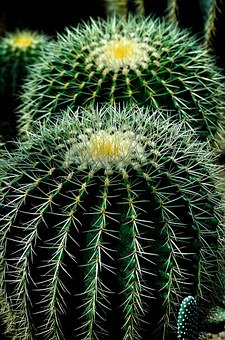
To know how cacti and succulents you need to know how they grow in their native inhabitants. A lot of cacti and succulents often grow in desert conditions of low moisture availability from the land and from the sky. The humidity is often low, the sun is bright and the temperature is unbearably hot. To compound this, cacti and succulents hate waterlog conditions. They do really have to put up with a lot.
These are not the only cacti and succulents that can be grown, as they are groups of succulents that grow on trees in rainforests, which requires more shade and higher humidity conditions. So it is advised to make sure you have the right growing conditions for each cactus and succulent you buy.
Cacti and succulents tend to grow slower than other houseplants, as they use a different form of photosynthesis.
THE BEST WAY TO CARE FOR HOUSEPLANT CACTI AND SUCCULENTS
Cacti and succulents like a loose, free-draining compost to prevent waterlogging and to replicate its natural growing environment. It is best to buy cacti and succulent house compost or if you are inclined you can make your own mix. You can mix 70% by volume of good quality houseplant compost with 30% horticultural grit. This will ensure that the dry conditions at soil level are maintained which the plants really thrive on.
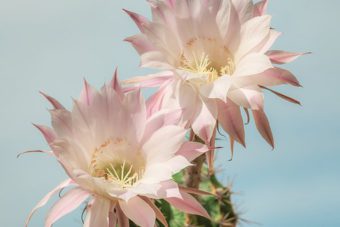
Once a cactus or succulent specimen starts getting root bound, it is better to pot on to the next available container size up, where it is better to repot in spring, where active growth is starting once more.
To repot you must remember that cactus are spiny and can be vicious, so you will need to wear a thick pair of gloves. I have found that oven mitts are the best to use when doing this. Take the plant out gently into your hands and move to the next container as quickly as possible, to avoid cause pain.
WHERE TO POSITION YOUR CACTI AND SUCCULENTS?
Most cacti and succulents can be placed on a sunny windowsill all year round, whilst forest-dwellers need to be grown in an area that gets some shade.
In winter, cacti and succulents need a period of rest, so the temperature has to be reduced to 8 to 10 degree Celsius at night. It should not be difficult to do if it is left on a windowsill but away from central heating. This is done to mimic the dry season in their native inhabitant.
Remember although these plants do not need a large amount of water it will need just enough water to keep it from shrivelling especially in winter. This means that central heating should not be a problem unless heat enters your windowsills in winter.
FLOWERING
It can be difficult to get cacti and succulents to flower, but to get them to perform you must reproduce their natural seasonal patterns. This includes the previously mentioned dormant period used to replicate a dry season. This is followed by a rainy season in which watering is increased.
This will trick the cacti to give a good display of flowers, You need to check to when plants will flower; it is flowers in spring, then a rest period in winter is required, but if it flowers in summer then a rest period in spring is required.
You have to make sure that you get it right.
WHAT ARE THE FEED, WATER AND AIR REQUIREMENTS?
In April until September, water cacti and succulents generously, allowing any excess water to drain away.
In between watering allow the compost to dry out slightly to prevent the plants from getting waterlogging.
If you are growing a forest growing succulent, you need to grow them in high humidity.
Between April- September the plants need feeding once a month with specialized cacti and succulent liquid fertiliser.
Cacti need good air circulation during the summer months so may need to place near an open window.
After September reduce watering to a minimum to encourage cacti and succulent to reach a period of rest. Allowing the compost to dry out near completely before watering again.
Some cacti, especially those who dwell in deserts can be left without water from the beginning of November to February as long as plants are not on over warm conditions.
Winter flowering cacti need to be treated differently, as they require watering and warm in winter. This is followed by a rest period in summer.
LOOKING AFTER YOUR CACTI AND SUCCULENTS
Dust is a major problem of cacti and succulents. It builds up in and around the plant. It is best to use a soft paintbrush or make-up brush to remove the dust. Alternatively, for succulents, you can use a damp cloth.
An old cactus plant can become overcrowded and the best way of tidying it up is to thin them out. This is a great way of propagating new specimens.
Pruning is not always necessary but may be required for some succulents and cacti.
HOW TO PROPAGATE NEW PLANTS
The growing habit is such a great indicator of what method of propagation can be used to increase your stock.
If your cacti grow up like a straight column (Columnar types as they are known) can be propagated by stem cuttings.
Branching cacti can be propagated by stem cuttings of side-shoots and stems that are growing by careful removal. Fleshy succulents can be propagated via leaf cuttings.
Clump-forming specimens tend to form offsets that can be lifted and divided individually planted in a container.
Another good way to propagate cacti and succulents us by planting seeds. To do this, sow seeds in spring in compost with added grit. Large seeds need to be covered to twice its depth whilst small seeds should be barely covered. If the seeds are very fine, too fine to handle, it can be mixed with silver sand and then add a thin layer on top of the compost in order to distribute the seeds evenly. Water well before adding the seeds, otherwise the seeds can get washed away.
Place a propagation lid on top of the seed trays and then keep them at a temperature of 21 degree Celsius in partial shade.
Allow air into the seed tray by lifting the propagation lid off every day and wipe off any condensation. Make sure it is moist at all times but not overly wet.
After 12 months the seeds should have germinated and be large enough to be transplanted into individual 7cm diameter pots. The plants can now be allowed to grow on.
What follows are the succulents and cacti that I recommend to be grown as houseplants:
AEONIUM ARBOREUM (Tree Aeonium)

This succulent has a rosette of shiny, purple leaves on truck-like stems, where it can grow up to 1.5m in height. It prefers being grown in gritty compost in temperature no lower than 7 degree Celsius in bright sunlight, with good air circulation.
Water regularly in summer but keep the compost almost dry in winter where it should be placed in a cooler place to allow it rest.
In summer feed established plants several times in summer, whilst young plants can be fed much less.
If you are looking for an alternative grow A. domesticum variegatum (Youth and Old Age) that has rosettes of green and cream leaves.
AGAVE AMERICANA (Century Plant)

This is an impressive succulent forming rosettes of long, narrow saw-edged leaves with spiky tips. A. americana is plain green in colour but ‘Mediopicta’ has thick, pale stripes down the middle of the leaves and grows much slower than the plain green variety. The plant can grow up to 1.2m in height when grown in a large container.
It is not an easy plant to look after, as that it requires a cool place in good, strong sunlight. Water well in summer leaving to dry out before re-watering, in winter hardly water at all. A mature plant may send up a tall flower spike but the plant will die soon after.
You need to feed moderately every month using a balanced liquid fertiliser in the summer months.
A. filifera has a rosette of incurved leaves covered in fine white marketing, whilst A. victoriae-reginae has dark green leaves that have white-edges.
ALOE

The aloes are pretty succulents that have a large number of different forms. The leaves of many forms are wither dotted or striped and this is where the appeal lies.
Aloe Vera is the commonest of all aloes. It grows up to 60cm in height and is the largest of all the aloes, with thick and fleshy leaves. It can flower producing tall spikes of yellow flowers but this is rare in the home environment.
It prefers to be grown in a warm and well-lit area. In the compost recommended early in this article. You need to ensure that you water moderately throughout the year and feed once in a while in the summer months.
Alternative grow A. variegata (Partridge Breast), which has clumps of erect pointed leaves that are dark green at the edge and are cross-banded silvery-green.
APOROCACTUS FLAGELLIFORMIS (Rat-Tail Cactus)
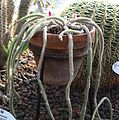
It gets its common name as the thin, long-rounded stems look like a rat’s tail. The stems are also covered in brown spikes. It is a forest cactus where in late spring to early summer, tubular, pink flowers are produced.
It needs to be grown in hanging baskets so that the 70cm tall stems have height to grow down from. It prefers to be grown in the shade in moderate humidity in summer in average temperatures. In winter, cooler temperatures are required but no less than 7 degrees Celsius.
Water moderately in summer and more frequently when it is in flower. In winter keep the compost almost dry. It needs total rest in winter in order to produce flowers next year.
After flowering in summer it is best to place it outside in a shady spot, whilst moderately watering and feeding once a month with a balanced liquid fertiliser.
ASTROPHYTUM MYRIOSTIGMA (Bishop’s Cap Cactus)

This is a globular cactus that is shaped like a bishop’s mitre, whose surface is whitish and floury. During summer, on top of the stem, yellow flowers are produced. An easy plant to look after but it requires total rest in winter in almost dry compost if it is to flower well in summer.
Grow in a very bright, airy windowsill, where the temperature must be kept greater than 7 degree Celsius. Not a large plant as it only grows up to 20cm in height.
Water moderately in summer but requires complete rest in winter. Does not require much feeding but an occasional feed in summer months will not go unnoticed.
CEPHALOCEREUS SENILIS (Old Man Cactus)

This is a striking column cactus covered with long silky hairs. It grows up to 1m in height but is very slow-growing. This is one cactus that likes the compost to be free-draining.
Grow in a moderately warm, bright and airy location. A windowsill is ideal. It needs to be watered moderately in summer without waterlogging and whilst actively in growth. Prefers to be nearly dry in winter. Feed moderately in summer with a balanced liquid fertiliser.
CEREUS PERUVIANUS (Column Cactus)

A tall ribbed column cactus that can grow up to 2m or more. The spines that are present are long and brown in colour, to encourage branching and the height the column grows up to, the column can be pruned. These pieces can be allowed to dry for a few days and then rooted in the cactus potting media. It is best to position in a bright, airy windowsill. Keep moist in summer by watering when required, barely so in winter.
For the plant to be at its best feed once in while with a high potassium feed.
CEROPEGIA WOODII (Hearts Entangled)

This is 2m long trailing succulent with long thread-like stems bearing small marbled heart-shaped leaves. In summer it produces dark red flowers. The flowers are not that important but the leaves are the main talking point.
The plant forms a larger tuber that can rot if it is exposed to too much moisture. The growing tip may need to be pinched out in order to encourage the plant to branch out.
Grow it in a hanging basket at a great height to allow the plant to trail downwards. Prefers moderate warmth, good air circulation in good, bright light. Water well in summer and much less in winter,
Feed once or twice in summer, no more or less. It is a strange-looking succulent but will do well in most homes.
CHAMAECEREUS SILVESTRII (Peanut Cactus)

This cactus has a creeping habit forming many prickly stems of 8mm thickness. In summer an abundance of scarlet, star-shaped flowers appear.
This is one of the easiest plants to grow, as it is not fussy in what compost it grows in. provided it drains quickly. Can survive neglect but will flower better, if it is given the right amount of care.
Best grown in a sunny, airy, windowsill in a shallow container, so the plant has room to spread. Temperature and humidity is not so important,
Water moderately in summer but hardly water in winter. When experiencing low temperature it can survive without water for ages. It may shrivel up but will recover quickly once watering resumes.
CRASSULA ARGENTEA (Jade Plant)

There are a large number if crassulas for indoor plant use. Some are grown for their succulent leaves, whilst others are grown for their flowers.
This is a succulent of shrubby habit that has thick branching stems. Each stem has oval, think glossy, green leaves. It is a tall plant growing up to 75cm in height. It can flower but it rarely does.
A very easy plant to grow as long as it is grown in any compost that is well-draining. To keep small, delay repotting as much as possible.
It prefers to be grown in cool to warm temperatures and can even survive near-freezing temperatures, bright light in airy conditions are all the plant requires
Water freely then allow the compost to dry out before repeating the watering cycle. In winter it is best to keep the compost near dry as possible.
A flowering alternative is C. falcata (Scarlet Paintbrush) that produces erect stems of thick, melon-shaped green leaves that are velvety to the touch. On top of this 60cm tall plant clusters of small, scarlet bell-shaped flowers are produced. This succulent may need more water than other succulents to survive.
ECHEVERIA SETOSA
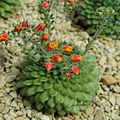
This can be seen as one of the most beautiful coloured of all foliage plants. They have a compact habit only growing up to 30cm in height and have hairs that are white, blue or silver.
This succulent has clumps of spoon-shaped green leaves with fine white hair and is tipped red at the margins. Do not put too much moisture around the base of the plant as this will lead to rotting. Best located in moderate warmth in a sunny windowsill that has plenty of air circulation. If this is met it will produce red flushes on short stems.
Water with tepid water all the year except in winter when the compost should be almost dry.
Look out for E. elegans and E. agavoides.
ECHINOCACTUS GRUSONII (Golden Barrel Cactus)

This globular cactus grows up to 1m high and it as an impressive plant that is easy to grow. It is round, dark green in colour and has ribs that are covered with shallow spines.
Flowers will not appear unless the plant is a few years old. After that, if it is well looked after, flowers will appear in spring and are usually bright yellow.
It is fairly easy to grow as long as it is grown in the cacti mixture recommended at the beginning of this article. Grow in a bright, airy but cool location. Whilst young a windowsill is ideal but as it gets bigger this can be problematic. Moderate water in summer is required but keep dry between waterings. In winter keep the plant dry, as it requires a rest period.
In summer, feed mature plants regularly throughout the summer months.
ECHINOPSIS
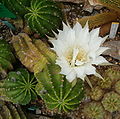
This cactus can be encouraged to flower whilst still young, which is unusual amongst cacti. The plants are deeply ribbed with impressive spines, which is their eye-catching feature.
The plants have two types of flowers. E. rhodotricha produces blooms that open during the day and close at night, E. eyriesii, on the other hand, open only at night and closes during the day. Both of these varieties have white flowers but yellow, red and pink are possible in other varieties.
This plant prefers to be grown in fully, bright light in warm condition all year round, where it grows up to 2m in height.
Water moderately in summer and keep the compost completely dry in winter. Feed once a month with a balanced liquid fertilizer during the growing season.
EPIPHYLLUM HYBRIDS (Orchid Cactus)

Epiphyllum is a large succulent that has large flowers, many of which are scented. Some species have flowers that open during the day, whilst other during the night,
The forest cactus that has flattened, fleshy, stems with jagged edges. In May-June, large showy flowers in shades of white, red and yellow appear. Can grow up to 90cm in height. This plant prefers warm, moderate humid conditions in light shade.
It prefers to be grown in a shaded windowsill that is not south facing. With age the plant becomes less attractive, the leaves become leggy, tall and lucid, It will also flower poorly. To avoid this problem, you will need to propagate frequently.
EUPHORBIA MILII (Crown of Thorns)

This is a shrubby plant that has narrow-green succulent leaves and vicious long spike along the stems, On top of these stems, clusters of red, yellow, or white flowers appear all year round, but more so in winter, The plant can grow up to 70cm in height.
To do well it needs reasonable warmth and goof light but away from direct sunlight. It likes lower humidity than most houseplants. This is a long-living plant as long as it gets the care it deserves. Overwatering is such a common problem with this plant, all you have to do is not to water for two months until new shoots are observed and the compost looks dry. Watering can be gradually introduced once again.
In spring and summit water generously but in autumn and winter water infrequently, so that the plant can rest.
Feed occasionally with a balanced liquid fertiliser.
EUPHORBIA OBESA

This cactus is nearly rugby ball in shapes with ridges, where the ridge meet, the flowers appear. The flowers are tiny and usually insignificant but have colourful surrounds.
You need to grow this cactus in bright, filtered light where it can grow up to 2m in height. It needs to be watered well in summer, but less so in winter. An occasional feed in summer will not go amiss as well.
GASTERIA VERRUCOSA

This is a compact plant only growing up to 15cm that has very textured and spotted leaves, the shape is what most cacti and succulent hunter look for.
The thick succulents leaves emerge vertically from the centre and then as they mature gradually fall down on top of the older leaves. So you have erect new leaves and stylish older, arching leaves, both on the same plant. The leaves themselves are attractive to look at, grey-green with flashes of red that are covered in raised white spots. In summer, orange flowers spikes are produced.
Grow it in a warm full bright windowsill. Water and feed regularly in summer, allowing the compost to dry out between waterings, in winter allow the compost to nearly completely dry out.
GYMNOCALYCIUM

This is a minute growing genus of cacti, where it only grow up to 12cm in height, the genus all flowers in early summer, where the blooms open during the day and close at night time.
What makes this Gymnocalycium plant unusual amongst cacti is that it does not require bright sunlight, and should ideally be kept in light shade, especially from the noon sun.
The beautiful flowers are either red, white, yellow or green. It prefers to be grown in warm temperatures in a slightly moist compost at all time. This includes winter. Feed occasionally with a liquid fertiliser when the plant is actually growing.
HAAGEOCEREUS PACALAENSIS

This 70cm tall, attractive cactus produces red flowers throughout the summer months. This is much smaller than in its natural inhabit where the cylindrical stems with its dark green leaves with yellow-tipped spines can grow up to 2m. It is not a compact plant compared to other cacti and succulents. The black and yellow spines are very attractive in this plant,
Grow it in a well-ventilated plant in direct sunlight in warm conditions. Water well over summer, slowing the compost to dry out in between waterings. Keep the compost dry in winter.
HAWORTHIA

This 20cm tall and neat compact succulent that has attractive fleshy patterned leaves. Most of these plants form rosettes of green, pointed leaves that stay close to the ground.
H. tessellata has a rosette of fleshy leaves that arch back, forming a central focal point. The leaves are covered with a network of fine lines.
H. fasciata have incurved leaves with white bumps, whilst H. reinwardtii has a thick column stem and looks nothing like the other two.
Grow this plant in bright, filtered sunlight in warm temperatures, but shade from the midday sun. This is a tough as boots cacti and will suffer neglect quite happily.
KALANACHOE

There are a number of species of this firm favourites that are often found around the home at Christmas time.
K. blossfeldiana is the most likely one to be found, where the species produce red, orange, yellow, pink, or white flowers appear. The flowers last several weeks. Its natural flowering time is spring, but it can be manipulated to flower throughout the year. After flowering, it needs resting for up to six weeks, where watering is slightly reduced.
Kalanchoe does not need much in the way of care, just keep the compost moist at all times, apart from the six weeks the plant is resting.
Other kalanchoes to grow are K. baharensis which have triangular succulent leaves covered in soft brown hair and this makes it feel hairy.
K. tomentosa also has soft hairy leaves that are brown in colour but the leaves are more grey-green in colour.
Grow it in warm conditions in bright indirect sunlight where it can grow up to 1m in height, feed once in a while during active growth.
LOBIVIA FAMATIMENSIS (Sunset Cactus)

This short, 1m tall column forming cactus has ribs that are edged with sharp spikes, which produces large, yellow flowers. Not a difficult plant to look after, all it needs is a bright light and airy conditions in a sunny windowsill.
You need to provide a cooler period in winter. In summer, water freely and in winter keep the compost nearly dry. In autumn and spring water ever so slightly.
MAMMILLARIA BOCASANA (Pincushion Cactus)
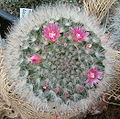
This is the most popular and widely grown of all cactus. The main reason is that they are easy to encourage to flower and they flower whilst the plant is young.
It is a small, 30cm tall plant that grows multiples of small mounds. Each mound is covered with short, spines. On top of each mound a ring of flowers are borne that come in a vast array of colours; bright pink, yellow and white.
Sometimes after the flower fades small pointed berries are produced that look ornamental. It is another easy plant to look after, all you need is warm conditions in bright sunlight. Keep the compost moist at all time, apart from a short period of rest after flowering. Feed occasionally when actively growing.
OPUNTIA MICRODASYS (Bunny Ears)
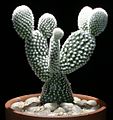
This genus makes attractive indoor plants, as their shape is formed by many branching rounded segments, just think of the cacti you see watching westerns to get an idea of what they look like.
Opuntias have rounded, flattened stems and new branches sprout from the tops or side of the stems.
They do not have spines but instead have tiny, barbed hairs, which are very painful if you accidentally brush against it.
This cactus can grow up to 90cm in height and it rarely flowers, but if it does it will be in spring on mature plants.
Another easy plant to grow, all it requires is that its compost is kept moist at all times, and a monthly feed of liquid fertilizer.
Grow it in a 13cm pot in bright, filtered light, where it will do well.
Alternatively, you can grow O. robusta (Prickly Pear) that is similar to bunny ears but is much more vigorous. Instead, the round segments are bluish-green and are more widely spaced. It can be a smaller plant or it can be a large plant, depending on your preference.
PACHYPHYTUM
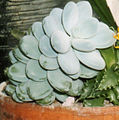
This 15cm tall succulent that is beautifully coloured and is compact in nature. It is closely related to Echeveria, as can be observed from the shape of the leaves and its colouring.
P. oviferum is known as the sugar-almond plant which is the one to grow. It has tight rosette of swollen leaves that look like almonds. The leaves themselves are blue-green and have a white colouring on top.
P. longifolium is another plant in the group that is worth looking for. Its rosette is not so tightly packed and the leaves are thinner, longer and curl inward. Grow it in warm conditions in bright, indirect light, but away from the noon sun. In terms of watering, just keep the compost moist at all times. P. ovirferum can produce flowers in spring and summer but these are hardly noticed.
PARODIA

This attractive cactus produces ball-shaped plants, and this makes it useful. It is often grown as a single ball, although multiple balls can be grown.
Varieties to grow include P. haselbergii (Scarlet Ball Cactus) which forms a neat round ball covered in short, white spines. This gives the appearance of a white snowball. In late winter or early spring, larges red bloom can be observed.
P. chrysacanthion, on the other hand, is covered with long, golden spikes that cover the green flesh below.
Grow them in warm conditions in bright, indirect light, where an occasional feed will not go amiss. Water lightly throughout the year.
REBUTIA SENILIS (Fire Crown)

These are small, growing 4- 10cm in height cactus that are popular amongst cacti lovers. They are compact and easy to flower. Many of these species will flower the first year from the planting of seeds. This and the ability to produce offsets, make them ideal houseplants.
R. senilis is a small spherical cactus that form clumps covered with numerous spines. In late spring to summer, bright red flowers are produced.
R. flebrigii, on the other hand, is covered in small white spines and the flowers are bright orange in colour.
R. minuscala is smaller and produces large pink-purple flowers that are huge in relation to the size of the plant.
R. pygmaea is even smaller with more cylindrical stems rather than round stems. It produces pink flowers instead.
Grow them in warm temperature in direct sunlight in moderate humidity. Unusually for a cactus, it requires an occasional misting in summer. Water thoroughly in summer and then allow to go almost dry between waterings. In winter keep the compost almost dry. Feed once a month during the summer months.
This is an attractive plant for all cacti collections.
RHIPSALIDOPSIS ROSEA (Easter Cactus)

This is a forest cactus that is neat. It starts off quite shrubby but then will start trailing, with branches of flattish, angled, succulent stems. In May to June flowers of carmine or white are produced.
Not a difficult plant to grow and it will survive almost freezing conditions of the compost is kept nearly dry. It will shrivel under these conditions, but will quickly bounce back if it is returned to warm and normal watering conditions.
Grow it in moderate warmth and humidity in light in winter but shade in summer. This is a plant for on top of books shelved, where its stems can be allowed to trail.
Water to ensure that the compost never totally dries out and mist throughout the summer months, less so in winter if it is in cool conditions. Feed the plant when the flowering buds start to appear.
SCHLUMBERGERA x BUCKEYI (Christmas Cactus)

This is a forest cactus that has trailing stems composed of flattish, succulent segments. With the right treatment, it produces massed of coloured pink or red bloom on the tips of brightly, green leaves. ‘Bristol Beauty; has dark, purple-red bloom.
S. hatiora ‘Donna‘ has bright red blooms, whilst S. truncata has flowers that are pink, white, orange or red.
Schlumbergera needs a rich compost, which is unusual for a cactus. It can be bought in flower and should be watered whilst the blooms last. Erratic watering can cause the flowering buds to drop. In summer the plant will benefit from a spell outdoors in a shady spot with regular amounts of.
Bring plants back in autumn. Reduce watering in autumn and also start feeding the flower buds appear. Grow in moderate warmth and humidity in good light. The compost needs to be kept moist at all times and drier if temperature drops in winter. Do not move plants when the flowering buds appear.
SEDUM

Various plants of the genus can be grown indoors, with their attractively coloured stems and leaves. Some even produce flowers regularly.
S. x rubrotinctum and S. pachphyllum produce thickish, fleshy leaves that are borne on typical succulent stem. Looks like green coral in a houseplant. The first plant flushes deep purple if the plant is placed in direct sunlight and produces yellow-blooms in winter.
S. pachyphyllum also flushes red leaves that run bright red at the tips.
There are two trailing plants that make good indoor plants and have different foliage types and shape.
S. sieboldii ‘Mediovariegatum’ has thin stems. The leaves are round, variegated and succulent, that are borne in groups of three that surround the stem/
S. morganianum has trailing fleshy stems that are completely enclosed in pale green cylindrical leaves. They produce small yellow flowers in winter.
Grow sedum in compost with lots of extra grit for better drainage. It can grow up to 80cm in height. You need to water plants well in summer and sparingly in winter, allowing the compost to dry out between watering. Give a balanced liquid fertiliser feed once a month during the growing season.
SENECIO ROWLEYANUS

This is a strange indoor succulent. It is the easiest and most attractive trailing plant that you can grow, the stems are thin are covered in leaves that are covered in pea-like leaves that are almost completely spherical. You need to plant it in a compost made up of organic matter and extra grit. |It can grow up to 60cm long and will long stunning trailing from a hanging basket.
Grow it in bright light in warm temperatures in a location that is well-ventilated, water well in summer and much less so in winter, allowing the compost to dry in between waterings. Feed regularly with a balanced liquid fertiliser in order to do well.
CONCLUSIONS
In this article, the best cacti and succulent houseplants to grow have been discussed. As you can see there are so many beautiful cacti and succulents to grow that have many different forms. Some looking strange, some producing the most elegant flowers you will ever see. What they all have in common are that they are easy to grow, needs little looking after and not taking much space.
They are also easy to propagate, as long as you do it right. Normally where you live, there is a cactus and succulent plant for you.
If you have any questions or comments that are pricking on your mind, please do so in the comment box below.
Happy cacti and succulent growing.

This post came at the perfect time…my succulent just died on me:( Or maybe I killed it. After reading your post, now I know how to take better care for it. The food, water, and air requirements is critical. The plant lady that sold it to me just told me about the water requirements:( She said water it once a week, not too much, and don’t get water on its leaves.
Succulent plants are the new rage because of its low maintenance and look really cute in their tiny pots. It was a nice house plant addition with its grey pot to our new house. I wish the plant lady told us how to properly care for it, especially where to place it in our house to get ample sunlight or air.
Thanks for the info! I hope our next succulent survives in our house:)
Hi Dana
Thank you very much for visiting my website and I hope you got a lot from this article. It is always upsetting when you lose the plant but with this article you will have a better selection and know how to look after them. They are tough plants and do not take a lot of looking after. So, do go for one.
Thanks
Antonio
I really enjoyed your article on succulents. My favorite is the MAMMILLARIA BOCASANA! They look cute and harmless. I like how easy they are to maintain and that they multiply without much effort.
Speaking of multiplying, where do you get seeds for succulents and cacti? Also, out of all those succulents, which ones is your favorite and why? What would you recommend for someone who lives in a damper region?
Thank you Linda
I always say if you want to get into houseplants buy succulents and cacti as they are easy to grow. You can have it for many years. You normally buy cactus are plants but you buy cacti as seeds through many of the seed catalogues, you have to be patient as they can take a long time to germinate. My favourite is the crown of thorns, as it neatly constantly in flower. As cacti is grown indoors then it doesn’t matter, as it will get the moisture from you.
Kind regards
Antonio
Wow! In this lockdown, with a lot of spare time in hand, I have developed a knack for gardening. And the next plants that I was planning to include in my inventory were some beautiful succulents. These plants are so amazing. They look so nice and some of them can even purify the air. This article has so much to offer on succulents. The best ones that you can get and how to look after them, how to make new plants out of the old ones; and some other brilliant advice, everything has been explained. This article is going to be a big help to me. Thank you for sharing. I learned more from this
Hi Samantha
I really enjoy that you have gotten a lot of information from it. You now know how to look after them, how to propagate them, the best plants to buy and how to have a beautiful home full of cacti and succulents.
Kind regards
Antonio
Helooo there, a big thanks to you for this beautiful article on the best cacti and succulents houseplants to grow, it’s very educational. Aloe vera is one plant I love so much, aloe vera can be best planted in a cactus potting soil mix or even a regular potting soil that has been amended with additional perlite or building sand…… Aloe vera are easy to grow indoors as a potted plant, and really makes a wonder houseplant.
Hi Sheddy
Thank you for your insight and your praises of the aloe vera plant. I love them myself and glad you now know how to grow them probably and avoid the potential heartache of losing it because you have overwatered I hope you will broaden your horizon and get more into your collection.
Kind regards
Antonio
Hello there, thanks a lot for sharing this wonderful piece of information here with us. I must say i really did enjoyed going through your article as it contains detailed information’s one needs to know before growing these cacti plants, and i think these tips will be of great help. Thanks for sharing
Hi Philebur
Once again thank you for visiting my website and I am glad you got a lot of information from this article. I do hope you buy one and then put it into practice.
Kind regards
Antonio
Hello there, thank you for this very detailed and informative post, Before the whole corona virus pandemic outbreak, I visited my lod school friend and I saw son very beautiful cacti and d succulent house plant and I really wanted to grow some in my house, but I have the challenge of know which to grow but this post right here has provided me with every information I’ll new to grow the best Cacti and succulents
Hi Jomata
You can never go wrong with cacti and succulents, as they are not demanding houseplants. When I write an article I want to be as detailed as possible and include as much information as possible. I hope you buy one for your son, as they do teach how to be responsible.
Kind regards
Antonio